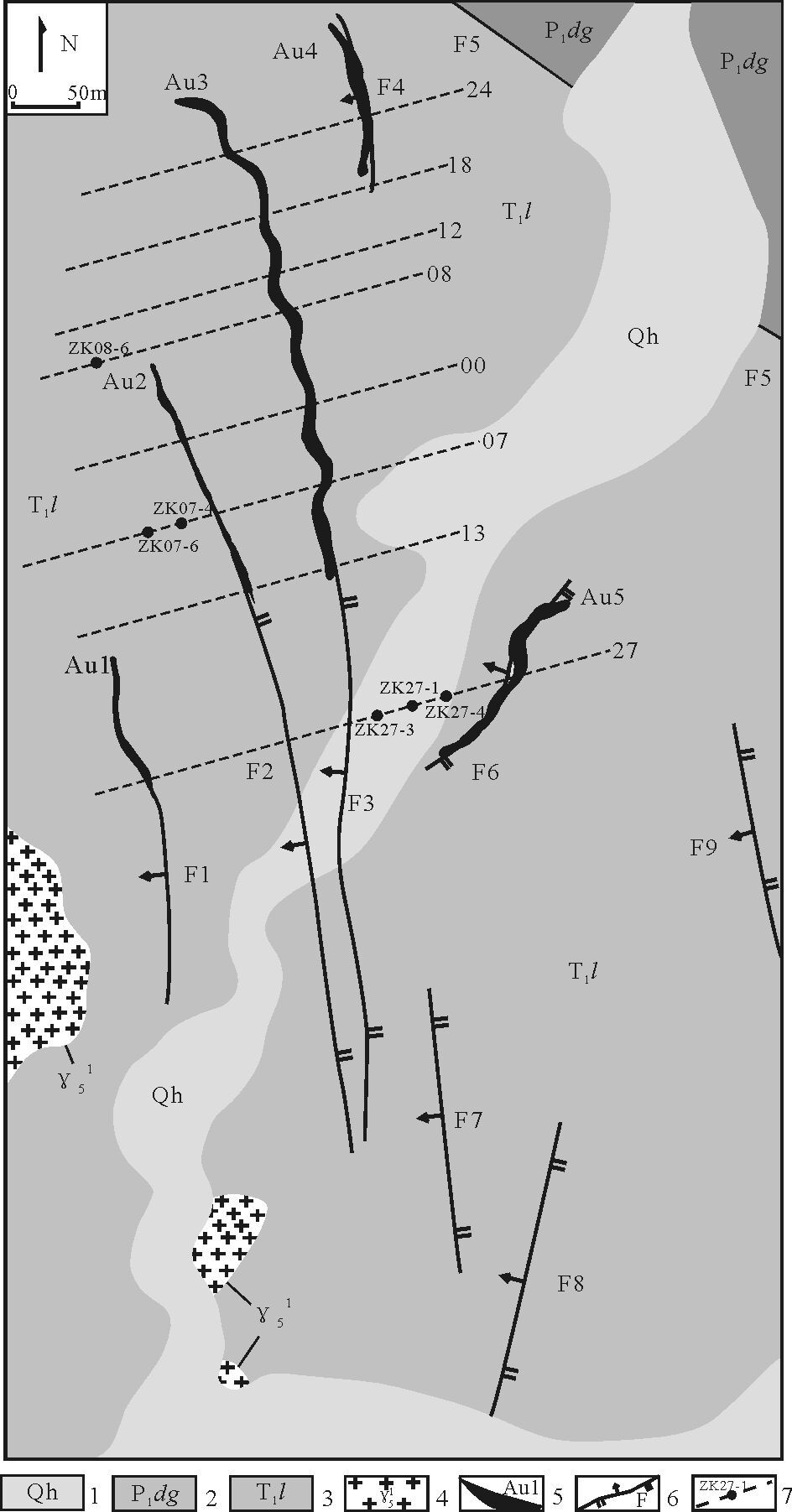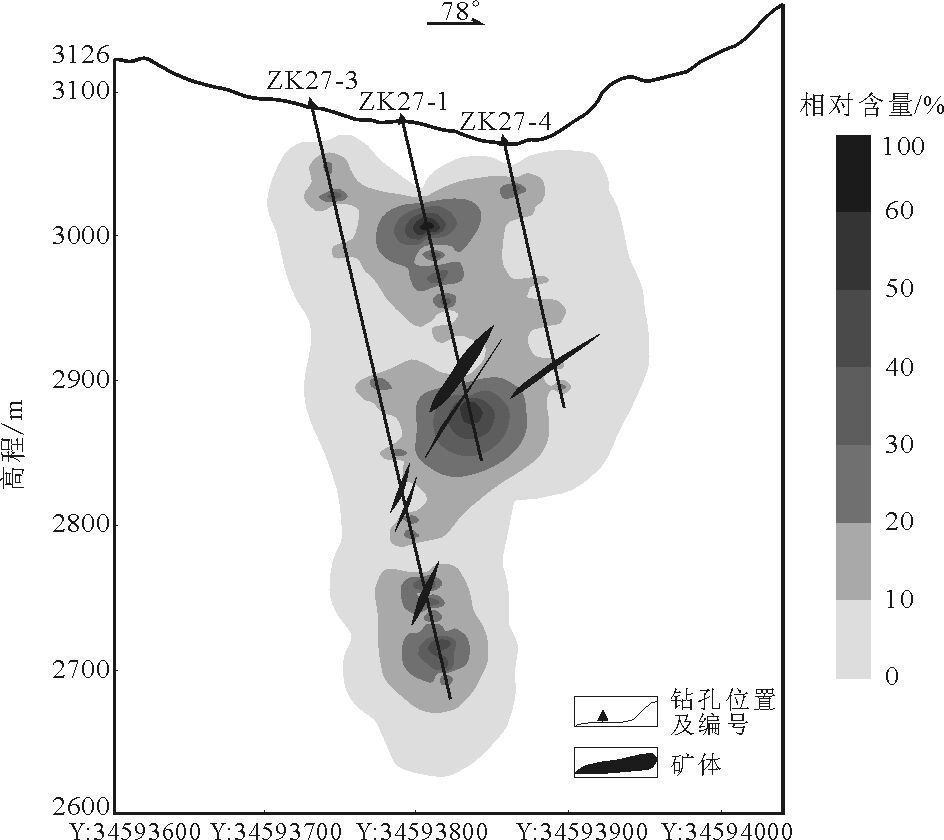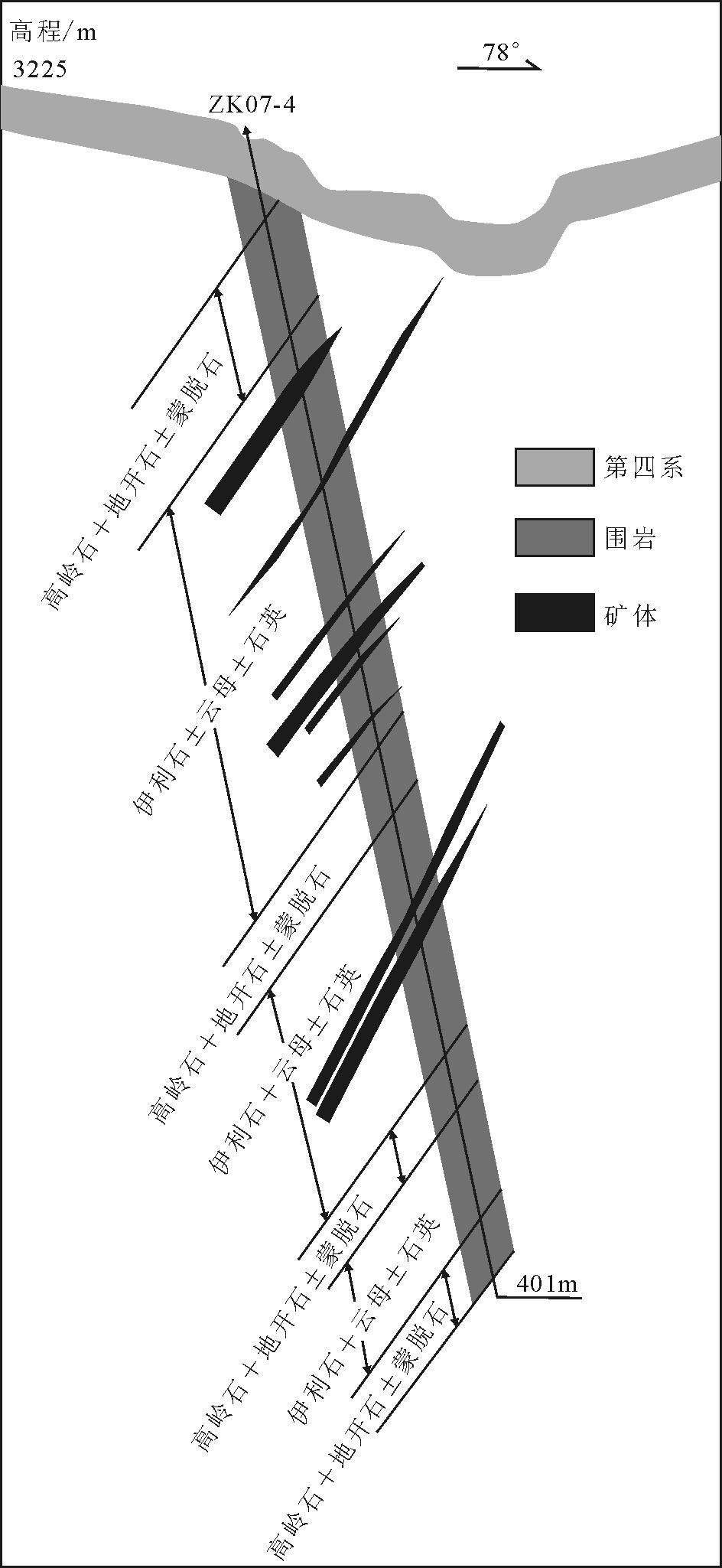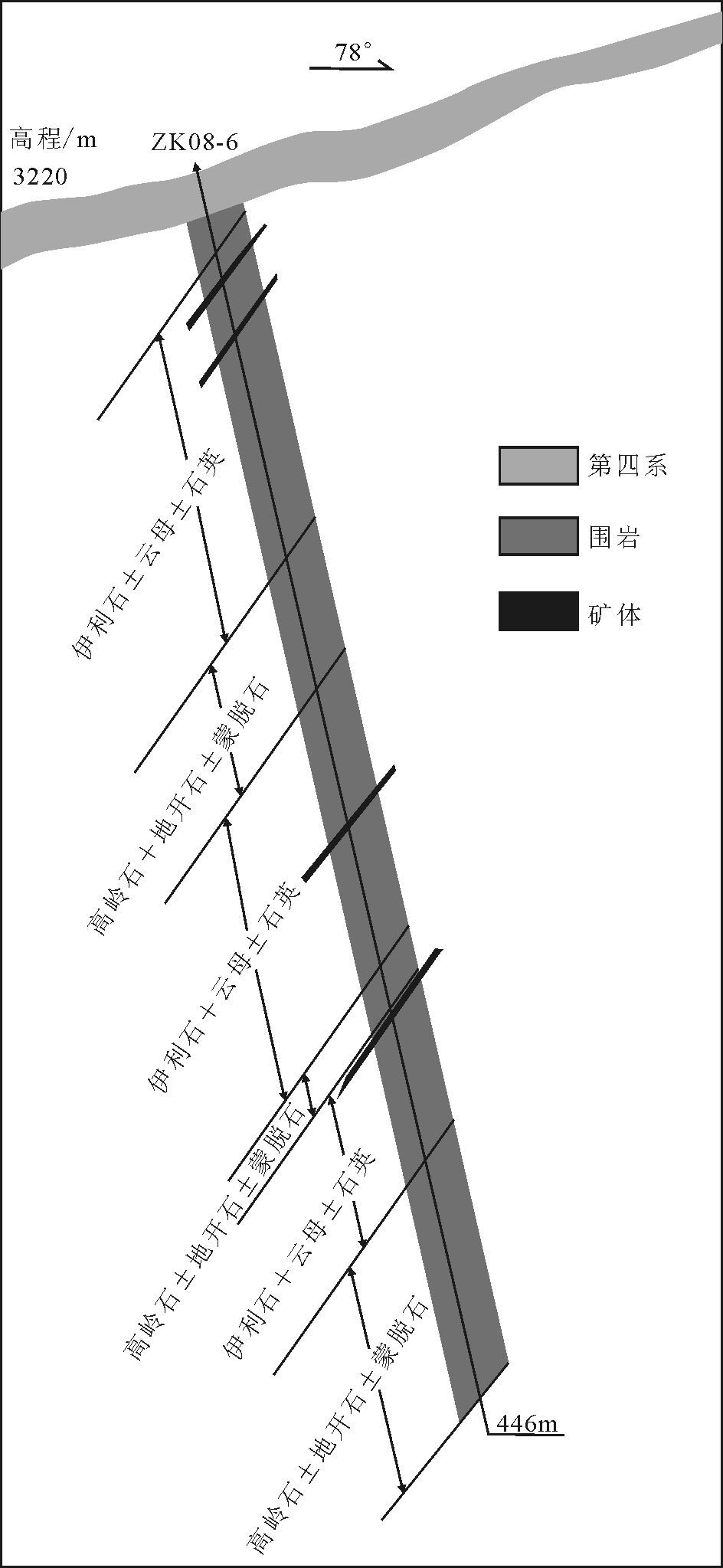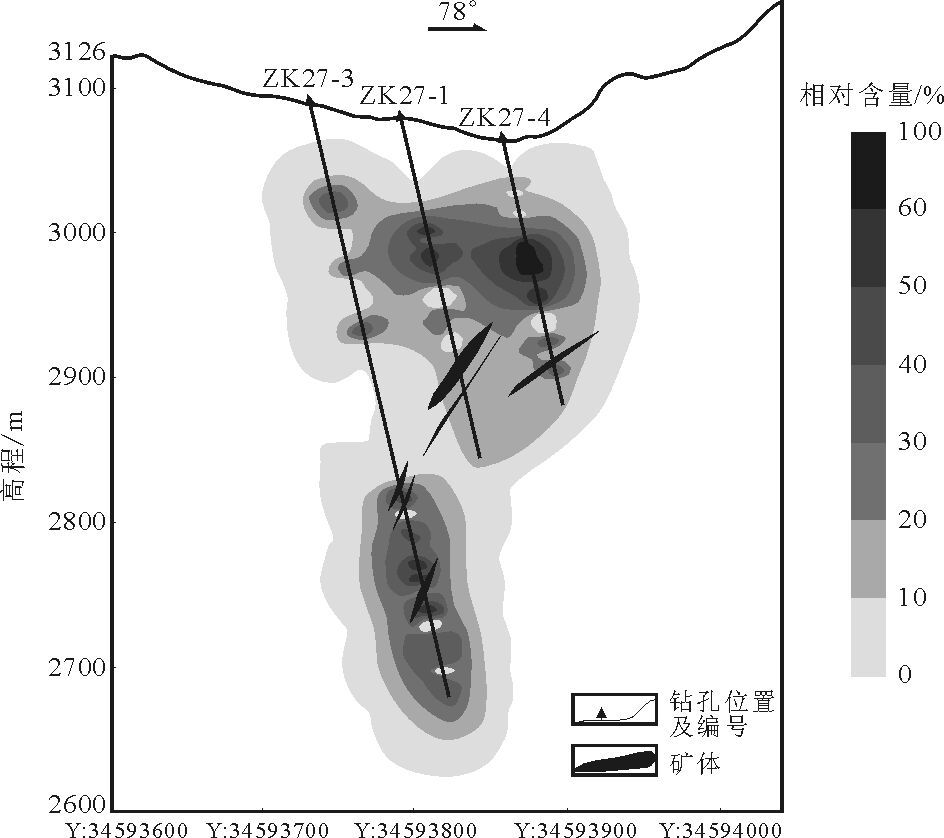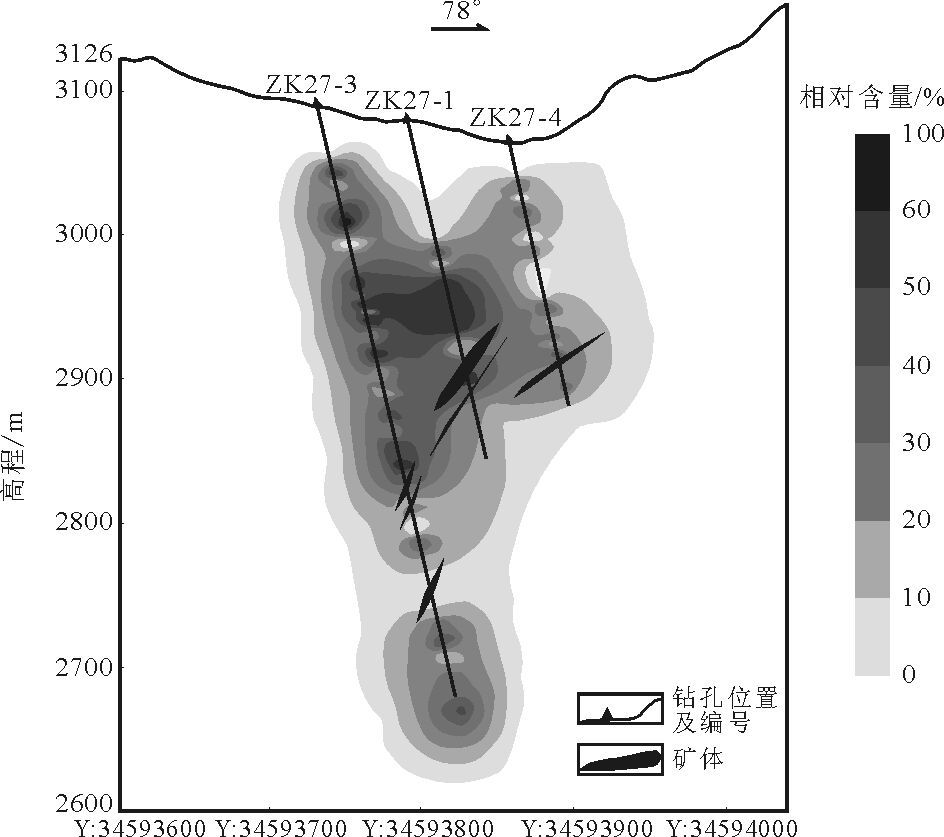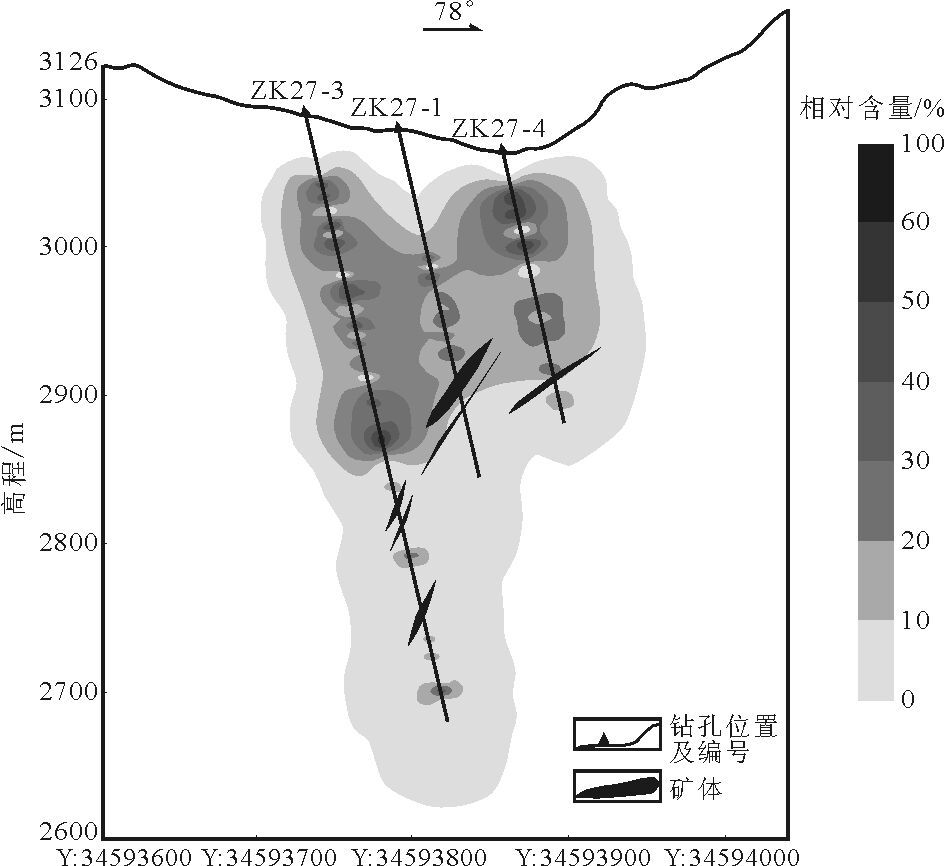The application of near-infrared spectroscopy to identify altered minerals and its implications for geologic prospecting: A case study of the Gangcha gold deposit in Gansu Province
-
摘要:
甘肃岗岔金矿位于秦岭造山带之碌曲-成县逆冲推覆构造带的西段北侧,是典型的构造蚀变岩型金矿床,目前储量可达中型。在矿区地质填图的基础上,采用BJKF-1型近红外矿物分析仪对矿区7号勘探线ZK07-4钻孔、8号勘探线ZK08-6钻孔及27号勘探线的ZK27-1、ZK27-3、ZK27-4钻孔岩心进行蚀变特征研究,识别出的主要蚀变矿物为伊利石、云母类、地开石、高岭石等。蚀变矿物分布及含量变化特点表明,与矿化有关的蚀变主要是绢英岩化,其中已探明矿体多位于采用近红外分析技术圈出的绢英岩化带内。此外,伊利石反射光谱特征参数计算结果表明,伊利石结晶度和Al-OH特征吸收峰形态呈现有规律的变化,即含矿段和近矿段伊利石结晶度大(SWIR-IC值5.5~5.7),Al-OH吸收峰尖锐;远矿段和无矿段伊利石结晶度小(SWIR-IC值1.3~1.5),Al-OH吸收峰平缓,显示含矿段伊利石形成温度较高。上述结果表明,矿区内绢英岩化蚀变及伊利石结晶度、Al-OH峰形是有利找矿标志,对找矿具有实际指导意义。
Abstract:Located on the northwestern side of Luqu-Chengxian thrust nappe zone in Qinling orogenic zone, the Gangcha gold deposit is a classical fractural alteration type gold deposit, in which the reserves of metal gold is up to medium scale. On the basis of geological mapping of the mining area, a BJKF-1 near-infrared mineral analyzer was used for drill hole ZK07-4 along No. 7 exploration line, drill hole ZK08-6 along No. 8 exploration line, and drill holes ZK27-1, ZK27-3, ZK27-4 along No. 27 exploration line to study the alteration characteristics. Some major alteration minerals were identified by the analyzer, which included illite, mica, dickite, kaolinite etc. According to the distribution and content changes of alteration minerals, phyllic alteration is related to mineralization, and the proven orebodies are mainly located in the phyllic alteration zone. Besides, a study of illite spectral reflectance parameters shows that illite crystallinity and Al-OH characteristic absorption peak patterns change regularly, that is to say that the ore part's illite crystallinity is large (5.5~5.7), the absorption peak of Al-OH is sharp, the surrounding rock's illite crystallinity is small (1.3~1.5), and the absorption peak of Al-OH is flat, suggesting that the ore-bearing part's illite was formed at high temperature. These results suggest that phyllic alteration, illite crystallinity and Al-OH profile can be taken as the indicator of mineralization during mineral exploration.
-
前人研究[1]表明,波长在780~2500nm 之间近红外光可以被C-H(甲基、甲氧基、羧基、芳基等)、羟基(O-H)、巯基(S-H)、氨基(N-H)等官能团选择性吸收,因而识别含有上述官能团的物质成为近年的研究热点之一。近几十年来,反射技术在区分层状硅酸盐矿物(如绿泥石、蛇纹石等)、含羟基硅酸盐矿物(绿帘石、闪石等)、硫酸盐矿物(明矾石、黄铁钾矾、石膏等)和碳酸盐矿物(方解石、白云石等)方面得到广泛应用。
20 世纪90 年代以来,根据上述原理开发的PI⁃MA 测量仪(Portable Infrared Mineral Analyzer)在澳大利亚、美国、加拿大、南非、智利和欧洲的许多矿业公司得到广泛应用,即通过识别蚀变矿物种类、丰度和成分,可有效地圈定热液蚀变带或矿化带,甚至可以半定量地估算蚀变矿物含量,给出成矿作用规模、强度等信息[2-5],使得蚀变矿物近红外识别技术备受关注。
为进一步探讨蚀变矿物时空变化与金矿化的关系,深度挖掘蚀变矿物的标型特征,指导找矿勘查,本文针对甘肃岗岔金矿,利用南京地质调查中心研制的便携式近红外矿物分析仪(BJKF-1)对蚀变岩中的蚀变矿物进行了系统测定和详细研究,为该矿勘查工作提供重要依据,对类似蚀变岩型金矿的勘查也具有指导意义。
1. 区域地质
岗岔金矿位于合作市北东方向约19km 的佐盖曼玛乡看木仓村和下加门村。矿床所在区域在大地构造位置上隶属于西秦岭造山带碌曲-成县逆冲推覆构造带(图 1-A),区内构造线总体为NWW 向展布。区域地层主要有下石炭统巴都组(C1bd)和下加岭组(C1x)、下二叠统大关山组(P1dg)、下三叠统隆务河组(T1l),以及新近系甘肃群(NG)、第四系松散沉积物。近年来,该区域金矿勘查取得了显著效果,已发现各类型金矿/点十多处,且多与NW—NWW 向深大断裂及广泛发育的印支期—燕山期岩浆岩存在密切关系。资料[14-15]表明,本区岩浆岩主要发育花岗闪长岩和石英闪长岩体,形成年龄168~245Ma。
2. 矿区地质
矿区出露地层主要为三叠系隆务河组(T1l),其主要岩性为蚀变安山岩、安山质火山角砾岩、集块岩、蚀变凝灰岩、凝灰质角砾岩等火山岩及火山碎屑岩组合;局部出露二叠系大关山组(P1dg),岩性为凝灰质砂岩、粉砂岩、砂质板岩、炭质板岩等组合。总体上,区内岩层呈倾向NWW 的单斜构造,局部地层由于褶皱倾向NE。第四系冲洪积层(Qh)分布于洼地及河谷地带。
矿区西南部出露的侵入岩主要为印支期花岗闪长岩和石英闪长岩体(图 2)。矿床产出于该岩体的外接触带,赋矿围岩主要是下三叠统隆务河组火山岩、火山碎屑岩,及其下伏下二叠统大关山组凝灰质砂岩、砂板岩。
矿区断裂构造发育,其中F1、F2、F3、F4、F5、F7、F9断层走向呈NNW—NW向展布,断层F6和F8走向呈NNE向展布(图 2)。目前矿区共发现和控制5条金矿脉,自西向东依次为Au-1、Au-2、Au-3、Au-4和Au-5号矿脉。野外调查和钻孔勘探工作显示,金矿脉的产出明显受控于几条主要断裂构造,以细脉状、浸染状产出于三叠系和二叠系的构造破碎带内。
矿体倾角均较陡,一般都大于50°。矿体沿走向膨缩变化、尖灭再现现象明显,目前已获探明储量近中型。
矿区最大的矿脉为Au- 3 号金矿脉,总体呈NNW 向展布,南段趋于近SN 向延伸,倾向W 或SWW,倾角50°~70°,地面走向延伸超过1km。矿体厚度一般为0.83~8.04m,平均厚度约2.91m,厚度变化系数为242.23%,矿石平均品位Au 2.99×10- 6,Ag8.64×10-6。
矿区内围岩蚀变主要发育褐铁矿化、黄铁矿化、绢英岩化、粘土化,局部发育硅化、碳酸盐化。
3. 工作方法
近红外矿物分析技术主要包括野外样品采集、样品测试和数据处理及解译3 个紧密相关的环节。其中数据处理及解译是核心环节。
3.1 样品采集
样品采自钻孔岩心,采样原则为非矿化段取样间距一般为2~5m,矿化段一般加密至1~2m。样品大小约4cm×4cm×4cm。
样品主要采自ZK07-4、ZK08-6 及ZK27-1、ZK27-3、ZK27-4 共5 个钻孔的岩心(钻孔位置见图 2),共计采样718 件。
测试仪器采用BJKF-1 型便携式近红外矿物分析仪。光谱波长范围为1300~2500nm,分辨率小于8nm,数据采集间隔大于8nm,样品扫描时间小于1min[16-17]。考虑到不同样品的吸收率差异,个别样品扫描时适当降低了扫描速度。
测量前清理样品表面浮尘,每个样品选取3 个不同方向的新鲜面测量[18-19],共获得反射光谱曲线2200 条。
3.3 数据处理与解译
对于BJKF-1测量获得的岩(矿)石光谱曲线,采用随机携带的矿物光谱分析专家系统MSA(MineralSpectral Analyser)软件首先进行解谱分析。解谱时采用自动和手工2种方法,分别将测量样品获得的谱线与随机携带的矿物数据库标准谱线进行反复比对,最终根据谱线特征吸收峰参数,识别提取矿物的蚀变信息(包括蚀变矿物种类、蚀变矿物出现频率,以及谱线特征吸收峰的峰强度、半高宽、峰位移等信息)。最后,采用Surfer软件,依据样品空间位置,编制蚀变信息空间变化趋势图,以表达蚀变信息空间变化规律。
4. 结果与解释
根据测试结果及数据处理,矿区内识别出的主要蚀变矿物(相对含量大于5%)有云母类、伊利石、高岭石、地开石;次要矿物(相对含量小于5%)有蒙脱石、方解石、石英;个别样品还检测出白云石、石膏、绿泥石、绿帘石等(图 3)。
4.1 主要蚀变矿物分布特点
由于蚀变矿物主要是岩石遭受热液交代的产物,所以其空间分布特征对矿化具有强烈的指示意义。样品主要采自第7 号勘探线ZK07-4 钻孔、第8号勘探线ZK08-6 钻孔和第27 号勘探线ZK27-1、ZK27-3、ZK27-4 钻孔,属于矿化区的中心部位,分析结果具有代表性。
4.1.1 云母类
云母类矿物主要指白云母、多硅白云母和珍珠云母等。其中白云母,尤其是多硅白云母被认为与金矿化关系密切[7]。本次测试结果显示,矿区内云母类矿物以白云母为主,含有少量珍珠云母,是矿区内分布最为广泛的蚀变矿物之一。从云母类矿物空间分布与矿体的关系看,云母类矿物主要出现于矿体内和近矿部位,如第27 号勘探线,3 个钻孔揭示出云母类矿物的空间分布具有明显的规律性,即云母类矿物相对含量高值区与矿化区段吻合较好(图 4)。另外,ZK07-4 及ZK08-6 中,云母类矿物相对含量高值区也主要出现在脉状、网脉状矿体内及其附近(图 5、图 6)。
4.1.2 伊利石
广义地讲,伊利石是一种层间阳离子亏损的2∶1型二八面体含水层状硅酸盐矿物,属于白云母族,是热液系统内常见的蚀变矿物之一[20]。工作区样品内识别出的伊利石相对含量仅次于云母类矿物。从第27 号勘探线伊利石的分布特点看,其高值区主要出现在矿体的上、下盘部位,远离矿体则含量明显较低(图 7);在ZK07-4钻孔内伊利石集中分布于矿化段,非矿化段则含量相对较低(图 5);ZK08-6钻孔虽然整体伊利石含量较低,但仍然显示其高值区与矿体化部位具有很好的吻合性(图 6)。整体看,伊利石与金矿化空间关系最为密切。
4.1.3 地开石
地开石为热液蚀变矿床中粘土化的常见产物之一[20]。本次研究发现,在第27 号勘探线,地开石高值区主要分布于矿体上盘(图 8),在ZK07-4 和ZK08-6 钻孔内主要分布于矿体及其上盘。但是,与云母类矿物和伊利石相比,地开石与矿体的空间关系不甚密切。
4.1.4 高岭石
从第27 勘探线高岭石分布规律图(图 9)可以看出,高岭石分布情况与地开石基本相同,但其含量明显低于地开石。结合ZK07-4 和ZK08-6 测试结果认为,高岭石主要分布于矿化部位的上盘外围,矿化部位和下盘则少有高岭石出现(图 9)。
4.2 蚀变矿物组合及蚀变分带
根据上述主要蚀变矿物的分布特点和相对含量变化规律,及其与矿体形态、品位的对应情况,发现岗岔金矿区主要存在2 个典型蚀变带,分别为绢英岩化带和高岭石-地开石化带。其中,绢英岩化带的蚀变矿物组合为白云母+伊利石±次生石英(次生石英的识别借助于光学显微镜),空间上一般位于矿体及近矿化部位;高岭石-地开石化带的主要蚀变矿物组合为高岭石+地开石±蒙脱石,多位于矿体的外围(图 10)。
一般认为,伊利石和白云母的形成与成矿流体活动有关,特别是高结晶度的伊利石和白云母常常属于典型的热液蚀变标型矿物[11]。岗岔矿区内金矿体主要分布于绢英岩化带内,说明金的富集与伊利石和白云母具有很好的成生联系,进一步说明伊利石和白云母为岗岔金矿的标型矿物。
4.3 伊利石Al-OH 特征峰及其找矿意义
如前所述,岗岔矿区伊利石与金矿化空间关系较为密切,因此伊利石的形成温度及结晶度对于矿化具有重要的指示意义。
多数学者[21-24]认为,在热液蚀变条件下,相对高温区形成的伊利石,其结晶度(依据X 射线粉晶衍射结果计算,简称XRD-IC)较高,表现为XRD-IC值较小;相对低温区,其结晶度较低,表现为XRDIC值较大。
Pontual 等①(Pontual S, Merry N, Gamson P. Spectral interpretation field manual, G- MEX. Arrowtown, New Zealand, AusSpec International Pty. Ltd., Unpublished Manual, 1997, 1: 168.)研究认为,短波红外仪也可以测试并计算伊利石结晶度(short wavelength infra-red il⁃lite crystallinity,简称SWIR-IC,具体计算方法如图 11 所示),即伊利石的SWIR-IC 值等于其2200nm处的短波红外吸收峰深度除以其1900nm 处的短波红外吸收峰深度;且计算[25-27]表明,温度越高,伊利石结晶度越高,其SWIR-IC 值越大,即相对高温区形成的伊利石,短波红外光谱表现为在2200nm 波长位置的吸收峰较为尖锐。
显然,伊利石结晶度SWIR-IC 值和Al-OH 特征吸收峰A 值(表示Al-OH 在2200nm 处特征吸收峰的峰高与半峰宽比值)是与伊利石形成温度有关的2 个非常重要的短波红外光谱学参数。利用短波红外光谱仪可以测得蚀变岩中伊利石的结晶度和Al-OH 特征吸收峰形态,进而可以计算伊利石的结晶温度。本次选择5 个钻孔共48 件岩心样品(取样位置见表 1)进行了伊利石结晶度和Al-OH 特征吸收峰A 值计算,结果如表 2~表 7。
表 1 伊利石Al-OH 特征峰分析取样位置Table 1. List of the locations of illite Al-OH characteristic peak analysis钻孔 ZK08-6 ZK07-4 ZK07-4 ZK27-1 ZK27-3 ZK27-4 矿脉 2 号脉 2 号脉 3 号脉 5 号脉 5 号脉 5 号脉 海拔高度/m 3191.6 3154.9 2948.9 2970 2699.7 2925.4 3189.6 3148.9 2936.9 2961 2697.7 2921.4 3183.6 3142.9 2931.9 2936 2695.7 2919.4 3181.6 3136.9 2920.9 2926 2691.7 2911.4 3179.6 3130.9 2913.9 2914 2689.7 2899.4 3177.6 3124.9 2909.9 2912 2687.7 2897.4 3176.6 3116.9 2907 3174.6 3110.9 2903 3172.6 2975.9 2902 3169.6 2956.9 2897 表 2 ZK07-4 Au-2号脉样品伊利石SWIR-IC 及A 值计算结果Table 2. Calculations of illite’s SWIR-IC & A from drill hole ZK07-4 gold vein Au-2编号 海拔高度/m 金品位/10-6 SWIR-IC A值(峰高/半峰宽) 1 3154.9 0.05 1.4036 5.0746 2 3148.9 0.05 1.4036 5.1105 3 3142.9 0.4 1.4042 5.1183 4 3136.9 3.3 5.5370 11.6783 5 3130.9 0.05 1.4046 5.0824 6 3124.9 0.05 1.4047 5.1157 7 3116.9 0.3 5.5296 11.4945 8 3110.9 0.05 1.4044 5.1156 表 3 ZK08-6 Au-2 号脉样品伊利石SWIR-IC 及A 值计算结果Table 3. Calculations of illite’s SWIR-IC & A from drill hole ZK08-6 gold vein Au-2编号 海拔高度/m 金品位/10-6 SWIR-IC A值(峰高/半峰宽) 1 3191.6 0.05 1.4040 5.1107 2 3189.6 0.05 1.3476 3.2559 3 3183.6 1.78 5.5619 11.5318 4 3181.6 0.05 1.4038 5.3288 5 3179.6 0.05 1.4047 4.7813 6 3177.6 0.05 6.8503 3.1588 7 3176.6 1.30 5.5420 11.6148 8 3174.6 0.89 5.5393 11.4752 9 3172.6 0.78 5.5406 11.4132 10 3169.6 0.05 1.4041 5.1209 表 4 ZK07-4 Au-3 号脉样品伊利石 SWIR-IC 及A 值计算结果Table 4. Calculations of illite’s SWIR-IC & A from drill hole ZK07-4 gold vein Au-3编号 海拔高度/m 金品位/10-6 SWIR-IC A值(峰高/半峰宽) 1 2948.9 0.78 5.5441 11.5766 2 2936.9 0.86 5.5414 11.5482 3 2931.9 0.05 5.5319 11.5107 4 2920.9 3.18 5.5399 11.4767 5 2913.9 0.05 1.4041 5.3590 6 2909.9 0.05 1.4042 5.0905 7 2948.9 0.35 5.5461 11.5277 8 2936.9 0.55 5.5509 11.4524 9 2931.9 0.73 5.5411 11.6234 表 5 ZK27-4 Au-5 号脉样品伊利石SWIR-IC 及A 值计算结果Table 5. Calculations of illite’s SWIR-IC & A from drill hole ZK07-4 gold vein Au-5编号 海拔高度/m 金品位/10-6 SWIR-IC A值(峰高/半峰宽) 2925.4 0.05 1.4029 5.1060 2 2921.4 0.05 1.4037 4.9854 3 2919.4 0.05 1.4035 5.0521 4 2911.4 1.07 5.5529 11.3363 5 2899.4 0.05 1.4042 5.0272 6 2897.4 0.05 1.4040 5.0545 表 6 ZK27-3 Au-5 号脉样品伊利石SWIR-IC 及A 值计算结果Table 6. Calculations of illite’s SWIR-IC & A from drill hole ZK27-3 gold vein Au-5编号 海拔高度/m 金品位/10-6 SWIR-IC 均值 A值(峰高/半峰宽) 均值 1 2699.7 0.05 1.4048 1.40478 5.0746 5.0746 2-1 2697.7 5.5378 11.2295 2-2 2697.7 0.05 5.5354 4.1593 11.8795 9.3424 2-3 2697.7 1.4047 4.9182 3 2695.7 1.33 5.5432 5.5433 11.5401 11.540 4-1 2691.7 5.5545 11.2570 4-2 2691.7 0.05 1.4049 4.1689 5.1774 9.2743 4-3 2691.7 5.5474 11.3886 5 2689.7 0.05 1.4043 1.4043 5.0602 5.0602 6 2687.7 0.05 1.4048 1.4048 5.0394 5.0394 表 7 ZK27-3 Au-5 号脉样品伊利石SWIR-IC 及A 值计算结果Table 7. Calculations of illite’s SWIR-IC & A from drill hole ZK27-3 gold vein Au-5编号 海拔高度/m 金品位/10-6 SWIR-IC 均值 A值(峰高/半峰宽) 均值 1 2699.7 0.05 1.4048 1.40478 5.0746 5.0746 2-1 2697.7 5.5378 11.2295 2-2 2697.7 0.05 5.5354 4.1593 11.8795 9.3424 2-3 2697.7 1.4047 4.9182 3 2695.7 1.33 5.5432 5.5433 11.5401 11.5401 4-1 2691.7 5.5545 11.2570 4-2 2691.7 0.05 1.4049 4.1689 5.1774 9.2743 4-3 2691.7 5.5474 11.3886 5 2689.7 0.05 1.4043 1.4043 5.0602 5.0602 6 2687.7 0.05 1.4048 1.4048 5.0394 5.0394 从表 2、表 3 可以看出,Au-2 号脉矿体及其附近伊利石的SWIR-IC 值较大,一般在5.5~5.7 之间,远离矿体则该值较小,通常在1.3~1.5 之间,说明近矿部位伊利石的结晶度较高,远离矿体伊利石的结晶度较低。另外,在矿体及其附近A 值较高,变化范围为11.4~11.7,远离矿体处则A 值较小,变化范围在3.1~5.4 之间,说明矿化部位伊利石2200nm 波长位置的吸收峰峰形陡峭且尖锐,同样说明近矿部位伊利石结晶度高。
同样地,Au-3 号脉矿体及近矿段的SWIR-IC值较大,在5.53~5.54 之间;远矿段SWIR-IC 值较小,一般在1.40~1.41 之间。矿体及近矿段A 值较大,在11.4~11.6 之间;远离矿体段A 值较小,在5.0~5.4 之间(表 4)。
表 5、表 6、表 7 是Au-5 号金矿脉的SWIR-IC值和A 值计算结果,同样可以看出,矿体及近矿段伊利石的SWIR-IC 值较大,变化范围为2.7~5.6;远离矿体处的SWIR- IC 值较小,变化范围为1.40~1.41。A 值变化范围在近矿段及矿体段较大,为7.2~11.7;远矿段A 值较小,在5.0~5.1 之间波动。不同的是,与Au- 2、Au- 3 号脉相比,Au- 5 近矿部位的SWIR-IC 值和A 值变化范围较大,推测Au-5 号脉附近热液活动更为复杂,因此SWIR-IC 值和A 值范围略显宽泛。
综上可知,表征伊利石结晶度的SWIR-IC 值和伊利石Al-OH 特征峰的A 值与矿化具有很好的对应性,对于岗岔金矿区找矿预测具有指示意义。
5. 结论及建议
(1)近红外光谱技术可有效识别金矿区热液蚀变矿物组合,并进行半定量测定,从而进行蚀变分带。采用BJKF-1 型便携式近红外矿物分析仪并结合镜下观察,对岗岔金矿区的蚀变分带研究结果表明,近矿蚀变主要为绢英岩化蚀变,矿物组合为白云母+伊利石±石英;远矿蚀变为高岭石+地开石±蒙脱石组合。
(2)采用BJKF-1 型便携式近红外矿物分析仪进行的伊利石结晶度(SWIR-IC)和Al-OH 特征吸收峰A 值分析表明,近矿部位伊利石SWIR-IC较大,变化范围一般在5.5~5.7 之间;远离矿部位该值较小一般在1.3~1.5 之间。同样地,近矿部位A值较大,变化范围一般在11.34~11.68 之间;远离矿部位A 值较小,一般在3.15~9.35 之间。这说明,近矿部位伊利石结晶度较高,远离矿体伊利石结晶度较低。
上述结论对于该矿深部勘查具有重要的指导意义。因此建议对该矿区开展热液蚀变矿物组合填图和伊利石结晶度(SWIR-IC)、A 值填图,为深部预测提供依据。
甘肃惠天然矿业公司在野外工作过程中给予热心帮助,中国地质大学(北京)董国臣教授对本文进行修改,修连存研究员、薄海军硕士、鲍林硕士在论文撰写过程中给予帮助,在此一并表示感谢。 -
表 1 伊利石Al-OH 特征峰分析取样位置
Table 1 List of the locations of illite Al-OH characteristic peak analysis
钻孔 ZK08-6 ZK07-4 ZK07-4 ZK27-1 ZK27-3 ZK27-4 矿脉 2 号脉 2 号脉 3 号脉 5 号脉 5 号脉 5 号脉 海拔高度/m 3191.6 3154.9 2948.9 2970 2699.7 2925.4 3189.6 3148.9 2936.9 2961 2697.7 2921.4 3183.6 3142.9 2931.9 2936 2695.7 2919.4 3181.6 3136.9 2920.9 2926 2691.7 2911.4 3179.6 3130.9 2913.9 2914 2689.7 2899.4 3177.6 3124.9 2909.9 2912 2687.7 2897.4 3176.6 3116.9 2907 3174.6 3110.9 2903 3172.6 2975.9 2902 3169.6 2956.9 2897 表 2 ZK07-4 Au-2号脉样品伊利石SWIR-IC 及A 值计算结果
Table 2 Calculations of illite’s SWIR-IC & A from drill hole ZK07-4 gold vein Au-2
编号 海拔高度/m 金品位/10-6 SWIR-IC A值(峰高/半峰宽) 1 3154.9 0.05 1.4036 5.0746 2 3148.9 0.05 1.4036 5.1105 3 3142.9 0.4 1.4042 5.1183 4 3136.9 3.3 5.5370 11.6783 5 3130.9 0.05 1.4046 5.0824 6 3124.9 0.05 1.4047 5.1157 7 3116.9 0.3 5.5296 11.4945 8 3110.9 0.05 1.4044 5.1156 表 3 ZK08-6 Au-2 号脉样品伊利石SWIR-IC 及A 值计算结果
Table 3 Calculations of illite’s SWIR-IC & A from drill hole ZK08-6 gold vein Au-2
编号 海拔高度/m 金品位/10-6 SWIR-IC A值(峰高/半峰宽) 1 3191.6 0.05 1.4040 5.1107 2 3189.6 0.05 1.3476 3.2559 3 3183.6 1.78 5.5619 11.5318 4 3181.6 0.05 1.4038 5.3288 5 3179.6 0.05 1.4047 4.7813 6 3177.6 0.05 6.8503 3.1588 7 3176.6 1.30 5.5420 11.6148 8 3174.6 0.89 5.5393 11.4752 9 3172.6 0.78 5.5406 11.4132 10 3169.6 0.05 1.4041 5.1209 表 4 ZK07-4 Au-3 号脉样品伊利石 SWIR-IC 及A 值计算结果
Table 4 Calculations of illite’s SWIR-IC & A from drill hole ZK07-4 gold vein Au-3
编号 海拔高度/m 金品位/10-6 SWIR-IC A值(峰高/半峰宽) 1 2948.9 0.78 5.5441 11.5766 2 2936.9 0.86 5.5414 11.5482 3 2931.9 0.05 5.5319 11.5107 4 2920.9 3.18 5.5399 11.4767 5 2913.9 0.05 1.4041 5.3590 6 2909.9 0.05 1.4042 5.0905 7 2948.9 0.35 5.5461 11.5277 8 2936.9 0.55 5.5509 11.4524 9 2931.9 0.73 5.5411 11.6234 表 5 ZK27-4 Au-5 号脉样品伊利石SWIR-IC 及A 值计算结果
Table 5 Calculations of illite’s SWIR-IC & A from drill hole ZK07-4 gold vein Au-5
编号 海拔高度/m 金品位/10-6 SWIR-IC A值(峰高/半峰宽) 2925.4 0.05 1.4029 5.1060 2 2921.4 0.05 1.4037 4.9854 3 2919.4 0.05 1.4035 5.0521 4 2911.4 1.07 5.5529 11.3363 5 2899.4 0.05 1.4042 5.0272 6 2897.4 0.05 1.4040 5.0545 表 6 ZK27-3 Au-5 号脉样品伊利石SWIR-IC 及A 值计算结果
Table 6 Calculations of illite’s SWIR-IC & A from drill hole ZK27-3 gold vein Au-5
编号 海拔高度/m 金品位/10-6 SWIR-IC 均值 A值(峰高/半峰宽) 均值 1 2699.7 0.05 1.4048 1.40478 5.0746 5.0746 2-1 2697.7 5.5378 11.2295 2-2 2697.7 0.05 5.5354 4.1593 11.8795 9.3424 2-3 2697.7 1.4047 4.9182 3 2695.7 1.33 5.5432 5.5433 11.5401 11.540 4-1 2691.7 5.5545 11.2570 4-2 2691.7 0.05 1.4049 4.1689 5.1774 9.2743 4-3 2691.7 5.5474 11.3886 5 2689.7 0.05 1.4043 1.4043 5.0602 5.0602 6 2687.7 0.05 1.4048 1.4048 5.0394 5.0394 表 7 ZK27-3 Au-5 号脉样品伊利石SWIR-IC 及A 值计算结果
Table 7 Calculations of illite’s SWIR-IC & A from drill hole ZK27-3 gold vein Au-5
编号 海拔高度/m 金品位/10-6 SWIR-IC 均值 A值(峰高/半峰宽) 均值 1 2699.7 0.05 1.4048 1.40478 5.0746 5.0746 2-1 2697.7 5.5378 11.2295 2-2 2697.7 0.05 5.5354 4.1593 11.8795 9.3424 2-3 2697.7 1.4047 4.9182 3 2695.7 1.33 5.5432 5.5433 11.5401 11.5401 4-1 2691.7 5.5545 11.2570 4-2 2691.7 0.05 1.4049 4.1689 5.1774 9.2743 4-3 2691.7 5.5474 11.3886 5 2689.7 0.05 1.4043 1.4043 5.0602 5.0602 6 2687.7 0.05 1.4048 1.4048 5.0394 5.0394 -
浦瑞良, 宫鹏. 高光谱遥感及其应用[M]. 北京:高等教育出版社, 2000. Crowley J K, Williams D E, Hammarstrom J M, et al. Spectral reflectance properties (0.4-2.5 Am) of secondary Fe-oxide, Fe-hydroxide, and Fe-sulphate-hydrate minerals associated with sulphidebearing mine wastes[J]. Geochemistry:Exploration Environment Analysis, 2003, 3:219-228. Crowley J K, Williams D E, Hammarstrom J M, et al. Spectral reflectance properties (0.4-2.5 Am) of secondary Fe-oxide, Fe-hydroxide, and Fe-sulphate-hydrate minerals associated with sulphidebearing mine wastes[J]. Geochemistry:Exploration Environment Analysis, 2003, 3:219-228.
Denniss A M, Colman T B, Cooper D C, et al. The combined use of PIMA and VULCAN technology for mineral deposit evaluation at the Parys Mountain mine, Anglesey, UK[C]//International Conference on Applied Geologic Remote Sensing, 13th, Vancouver, BC, Canada, Ann Arbor, Environmental Research Institute of Michigan, Proceedings, 1999:25-32. Denniss A M, Colman T B, Cooper D C, et al. The combined use of PIMA and VULCAN technology for mineral deposit evaluation at the Parys Mountain mine, Anglesey, UK[C]//International Conference on Applied Geologic Remote Sensing, 13th, Vancouver, BC, Canada, Ann Arbor, Environmental Research Institute of Michigan, Proceedings, 1999:25-32.
Yang K, Huntinton J F, Browne P R L, et al. An infrared spectral reflectance study of hydrothermal alteration minerals from the Te Mihi sector of the Wairakei geothermal system, New Zealand[J]. Geothermics, 2000, 29:377-392. Yang K, Huntinton J F, Browne P R L, et al. An infrared spectral reflectance study of hydrothermal alteration minerals from the Te Mihi sector of the Wairakei geothermal system, New Zealand[J]. Geothermics, 2000, 29:377-392.
Yang K, Browne P R L, Huntington J F, et al. Characterizing the hydrothermal alteration of the Broadlands-Ohaaki geothermal system, New Zealand, using short-wave infra-red spectroscopy[J]. Journal of Volcanology and Geothermal Research, 2001, 106:53-65. Yang K, Browne P R L, Huntington J F, et al. Characterizing the hydrothermal alteration of the Broadlands-Ohaaki geothermal system, New Zealand, using short-wave infra-red spectroscopy[J]. Journal of Volcanology and Geothermal Research, 2001, 106:53-65.
连长云, 章革, 元春华. 短波红外光谱矿物测量技术在普朗斑岩铜矿区热液蚀变矿物填图中的应用[J]. 矿床地质, 2005, 24(6):621-637. 连长云, 章革, 元春华, 等. 短波红外光谱矿物测量技术在热液蚀变矿物填图中的应用——以土屋斑岩铜矿床为例[J]. 中国地质, 2005, 32(3):483-495. 章革, 连长云, 元春华. PIMA在云南普朗斑岩铜矿矿物识别中的应用[J]. 地学前缘, 2004, 12(40):460. 章革, 连长云, 王润生. 便携式短波红外矿物分析仪(PIMA)在西藏墨竹工卡县驱龙铜矿区矿物填图中的应用[J]. 地质通报, 2005, 24(5):480-484. 赵利清, 邓军, 原海涛, 等. 台上金矿床蚀变带短波红外光谱研究[J]. 地质与勘探, 2008, 44(5):58-63. 曹烨, 李胜荣, 申俊峰, 等. 便携式短波红外光谱矿物测量仪(PIMA)在河南前河金矿热液蚀变研究中的应用[J]. 地质与勘探, 2008, 44(2):82-86. 孟恺, 申俊峰, 卿敏, 等. 近红外光谱分析在毕力赫金矿预测中的应用[J]. 矿物岩石地球化学通报, 2009, 28(2):148-156. 张篷, 许虹, 孙雨沁. PIMA在金矿床热液蚀变矿物分带中的应用[J]. 中国矿业, 2011, 20(zk):155-187. 周俊烈, 随风春, 张世新. 甘肃省合作市德乌鲁岩体及外围金多金属成矿区成矿地质特[J]. 地质与勘探, 2010, 45(5):779-786. 骆必继, 张宏飞, 肖尊奇. 西秦岭印支早期美武岩体的岩石成因及其构造意义[J]. 地学前缘, 2012, 19(3):201-211. 修连存, 修铁军, 陆帅, 等. 便携式矿物分析仪研制[C]//当代中国近红外光谱技术——全国第一届近红外光谱学术会议论文集. 北京, 2006:193-202. 高庆柱, 修联存. 近红外矿物分析仪研制与应用[J]. 现代科学仪器, 2009, 1:30-33. 修连存, 郑志忠, 俞正奎, 等. 近红外分析技术在蚀变矿物鉴定中的应用[J]. 地质学报, 2007, 81(1):584-459. 修连存, 郑志忠, 俞正奎, 等. 近红外光谱仪测定岩石中蚀变矿物方法研究[J]. 岩矿测试, 2009, 28(6):519-523. 王濮, 潘兆橹, 翁玲宝, 等. 系统矿物学[M]. 北京:地质出版社, 1987. Duba D, Williams-Jones A E. The application of illite crystallinity, organic matter reflectance, and isotopic techniques to mineral exploration:A case study in southwestern Gaspe, Québec[J]. Economic Geology, 1983, 78:1350-1363. Duba D, Williams-Jones A E. The application of illite crystallinity, organic matter reflectance, and isotopic techniques to mineral exploration:A case study in southwestern Gaspe, Québec[J]. Economic Geology, 1983, 78:1350-1363.
Frey M. Very low-grade metamorphism of clastic sedimentary rocks[C]//Frey M. Low Temperature Metamorphism, Blackie and Son Ltd., Glasgow, 1987:9-58. 王河锦, 陶晓风, Rahn M. 伊利石结晶度及其在低温变质研究中若干问题的讨论[J]. 地学前缘, 2007, 14(1):151-156. Tang Y, Sang L K, Yuan Y M, et al. Illite crystallinity mapping of very low grade metamorphism of Triassic metapelites in the Zoige Area, Western China[J]. Acta Geologica Science, 2012, 86:96-105. Tang Y, Sang L K, Yuan Y M, et al. Illite crystallinity mapping of very low grade metamorphism of Triassic metapelites in the Zoige Area, Western China[J]. Acta Geologica Science, 2012, 86:96-105.
Chang Z S, Hedenquist J W, White N C, et al. Exploration tools for linked porphyry and epithermal deposits:Example from the Mankayan intrusion-centered Cu-Au district, Luzon, Philippines[J]. Economic Geology, 2011, 106:1365-1398. Chang Z S, Hedenquist J W, White N C, et al. Exploration tools for linked porphyry and epithermal deposits:Example from the Mankayan intrusion-centered Cu-Au district, Luzon, Philippines[J]. Economic Geology, 2011, 106:1365-1398.
徐庆生, 郭建, 刘阳, 等. 近红外光谱分析技术在帕南铜-钼-钨矿区蚀变矿物填图中的应用[J]. 地质与勘探, 2011, 47(10):107-112. 杨志明, 侯增谦, 杨竹森, 等. 短波红外光谱技术在浅剥蚀斑岩铜矿区勘查中的应用——以西藏念村矿区为例[J]. 矿床地质, 2012, 31(4):699-717.



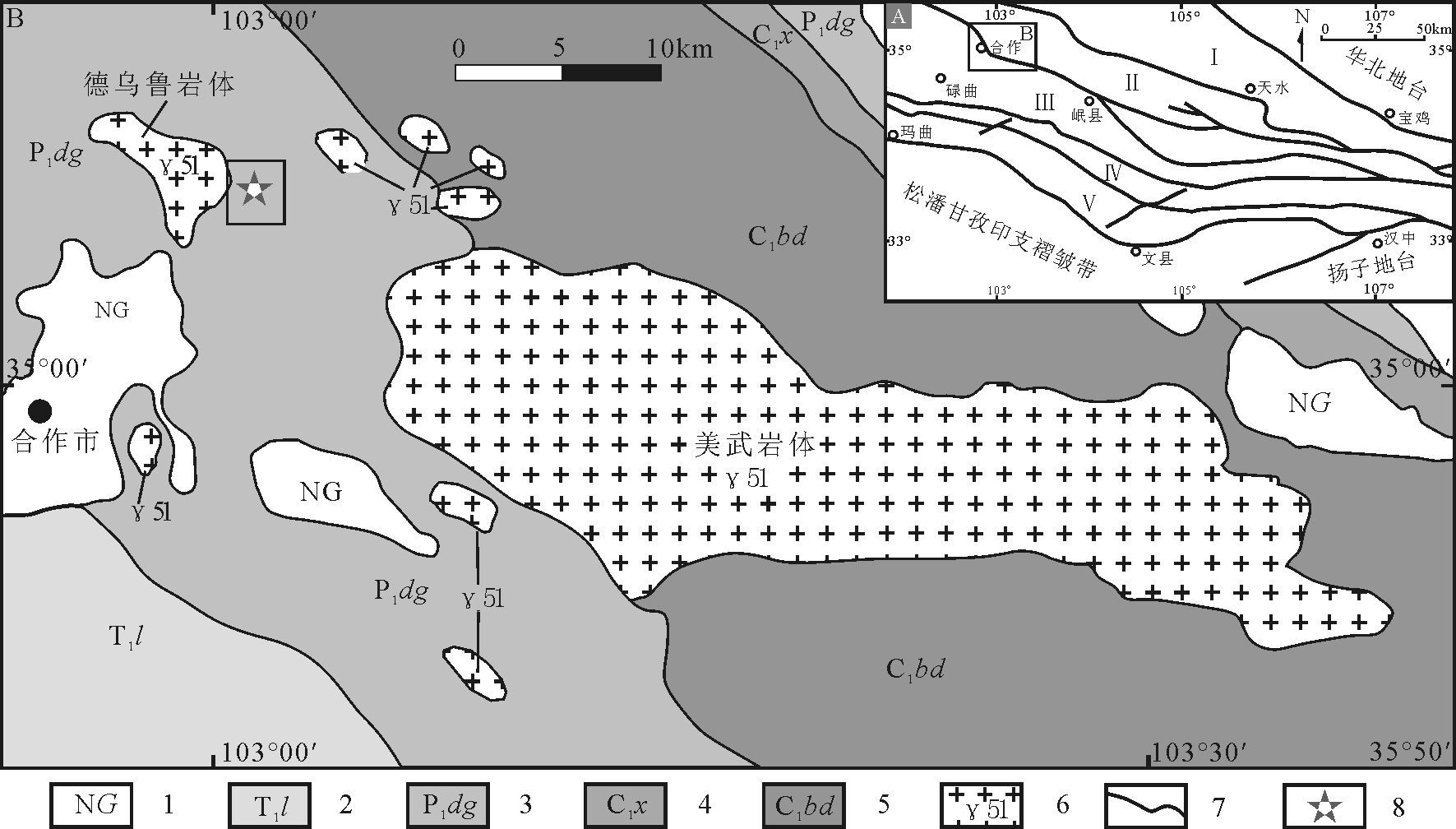
 下载:
下载:
